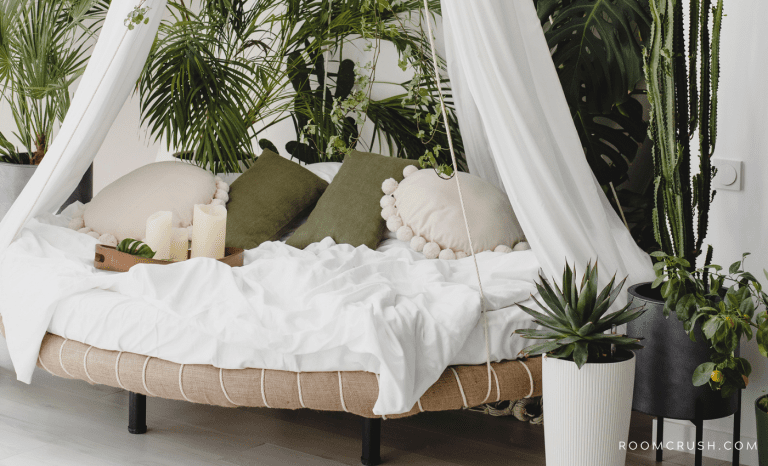How to Prepare Your Garden for Fall

Every gardener wants a blooming spring garden. And the prepping for the spring season starts in the fall. If you’re a gardener who’s wondering about what to do with your garden or yard this fall, let’s give you some tips to prepare your garden for fall.
The inevitable slowing down of activity in the garden shouldn’t discourage your green inspiration because the right garden prep and maintenance tips will go a long way.
Outside the tropics, autumn- usually called fall – marks the transition from summer to winter, when the duration of daylight becomes noticeably shorter and the temperature cools considerably.
This site uses ads and affiliate content as an Amazon associate earning on qualifying purchases. Disclosure.
After a steaming hot summer, most gardeners have to deal with gardens and yards that need updating. Good thing, the cooler temperatures in the air are easier on plants with the soil still being warm enough to allow roots to grow until the ground freezes.
That’s why autumn runs a close second to spring as an ideal planting time since the short, bright days, cool temperatures, and reliable showers provide an ample opportunity for plants to grow roots and get off to a good start in their new home.
To help your garden navigate the fall, try these prep and maintenance practices:
Autumn-Clean Your Garden
Planning a successful fall garden hinges on the proper management of spring and summer plantings. You want to get in there and harvest all your summer crops ASAP to make room for fall plantings.
Before it gets too cold, clean up plant debris and weeds, the pots and seed trays in preparation for next year’s spring sowing and planting, and just clear your sheds, garden rooms, and greenhouses.
You also want to clean and store everything, including the gardening tools, away for winter.
Remove any dead plants as soon as possible to ensure fungal disease and many garden pests don’t find a home in these dead leaves and stems.
Prune any overgrown shrubs while avoiding cutting off fruits, nuts, and berries too early in the season since they are valuable food for wildlife in the winter months.
Take the time to cut out any dead or diseased wood to prevent them from tumbling down in the harsh winds of winter and causing damage to your garden.
However, if it’s unsafe for you, bring in skilled personnel to do the job for you.
Check Your Outdoor Living & Water Features
Autumn is such a good time to pressure wash the patio or scrub down the decking in order to stop excessive dirt and grime build-up occurring over the wet winter months, making them slippery and slimy.
Also, check that garden rooms are watertight, secure, and intact since winter storms can be very destructive if the wind gets under the roofing felt.
You should also clean your gutters once all autumn leaves have dropped and remove any old moss from the roofs if safely accessible.
If you get a few warm dry days in a row, consider giving wooden buildings like your garden room a coat of preservative paint, being careful not to seal damp into the timber.
Additionally, remember to winterize your lawn furniture and water features with netting to collect any fallen leaves. And, repair your fences to ensure they are n blown over or been damaged by weather.
Amend the Garden Soil
Do a soil test to determine if you need to amend your garden soil before next year’s planting season.
If your soil requires a boost, add compost to your soil now to ensure it has enough time to break down and integrate into the soil over the winter, and as the soil nutrients are restored, your plants will get a good start in the spring.
Healthy plants from your summer vegetable garden, particularly those that can’t be brought inside before winter, make such good compost.
You can also burn garden waste that cannot be composted or put to other good use and use the valuable ash for your garden. This will help you to easily get rid of diseased and woody material and weeds.
Divide & Replant
Division is a great propagation technique that allows you to add to your collection of perennials.
To do this, dig up the parent plant that you intend to reproduce and quite simply divide it into many plants, depending on the size of the parent plant. Afterward, you can plant them.
Water them well until the ground freezes as this encourages them to grow new, healthy roots before they go dormant for the winter.
Some perennials will require shearing, or cutting back since they can’t handle the cold weather well. Most of them don’t remain attractive after the first frost, and the cold can lead to recurrent problems with pests and diseases.
Thus, cutting back certain perennials can protect them from the cold and spark healthy growth come spring.
Fix the Lawn
Before it gets super cold, give your lawn a really good cut because the cold & wet weather of winter will make it impossible to cut any long grass.
Also, help your lawn recover from busy summer activities by applying an autumn-winter feed that will perk your lawn up and protect the grass during harsh winter conditions.
However, if your soil is badly compacted thanks to summer backyard games, consider re-turfing.
Plant Spring Bulbs
As a wise gardener, get everything in the ground before the ground freezes, including any plants in their nursery pots as they will be better protected in the ground.
Consider busing spring bulbs as they store their food in for use during the resting stage in winter. Thus, their survival as they await blooming in spring.
Bulbs like daffodils and tulips will reward you with such a beautiful and colorful bloom in the spring.
You can also go for other amazing spring-flowering bulbs like:
- Scilla,
- Dwarf iris,
- Winter aconite,
- Fritillaria.
- Hyacinth is also a good option if you like scented plants- you want to pop some planters near the front door for perfumed air that makes your entrance each time.
Instead of flowers, there are plants that can also be planted in your fall garden. They include beets, carrots, onions, garlic, scallions, asparagus, and broccoli.
Dig up and bring in any sensitive bulbs or tubers. This will depend on your USDA plant hardiness zone, but anywhere there is an extended freeze, the plant should be brought indoors.
Plants Trees & Shrubs
It is great to plant trees and shrubs in the fall. The combination of cooler temperatures and fall rain allows trees to establish their roots, making it easier on them to adjust to extreme heat or drought in the summer.
Before planting, evaluate the space to make sure it will be suitable for your tree as it grows. Be cautious of planting too close to surrounding structures. You’ll also want to consider how much sun, shade, and moisture the tree will get at the planting site.
After planting, always mulch a two to a three-inch ring of mulch around the base of your tree—but don’t pile it against the trunk. Also, water your tree right after planting, even if it’s cold outside.
Note that if you wait too long into the fall season (November – December) to plant, you run the risk of poor root growth and increased failure rate.
Thus, start that new hedge or establish a new shade tree in your yard while the soil is still warm enough for roots to grow a little before winter sets in.
Avoid planting evergreens in mid-late fall because they keep their foliage all winter, thus, they are more susceptible to drying out when the soil freezes and the winds are blowing.
Plant them several months before for them to develop a sizeable root system that they can better prepare them to face the winter challenges.
This is especially important for broadleaf evergreens like holly since their large leaves are far more likely to get windburned and drought-stressed than conifers with a needle or scale-like foliage.
Weed Thoroughly
Weeding in fall can save your work come springtime. In early autumn — before the leaves begin to fall — is a great time for fighting weeds.
After all, no gardener wants to deal with pesky weeds come next year. Be sure to thoroughly pull out every weed in your garden.
You’ll also want a weed killer that combines a pre- and post-emergent herbicide. This is because some weeds will already be growing, which the post-emergent herbicide will kill, and weeds that haven’t yet sprouted will be taken out by the pre-emergent herbicide.
Mulch Your Beds
Mulching is an important step to take for your gardens.
Mulching over the winter protects the soil from erosion, maintains the moisture in the soil after watering the plants, blocks out light to inhibit weed growth, and adds organic matter to your soil making your garden be healthier in the spring.
For the best result, use mulch that is at least 3-4 inches thick. This is an excellent insulator for plants that can withstand some freezing temperatures and snow.
Rake & Clear Away the Leaves
Don’t let the leaves build up.
Instead, rake the leaves onto the lawn and mow them with a grass catcher to provide the soil with nutrients as they break down. If you don’t, they will soon turn to mulch and become slippery and dangerous.
You can also create a leaf mold that organic matter to your soil and is a great way to recycle fallen leaves. Once these leaves reach a crumbly texture, spread as a mulch throughout your borders.
You can also use these autumn leaves as compost, especially after shredding them,
Keep your patio area or deck clear of autumn leaves and sweep off dusty deposits before they turn to mud. As well, tackle any algae growing in shadier parts.
Ensure you’re properly preparing your garden now that fall is here. This will make it bloom come next year!
Which of these tips have you done to prepare your garden for fall?
Related – How to get your outdoor space ready for Summer







